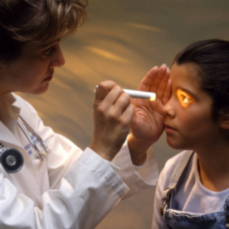Children with Epilepsy
As can be seen from the birth to six section of this course, epilepsy is a disorder that can have serious impact on the development of children. In epilepsy, children can experience different types of seizures (see full Glossary). Some seizures involve loss of consciousness (for example: tonic clonic, formerly known as grand mal) and others do not (for example, absence seizure, formerly known as petit mal). Some seizures involve the entire brain (known as generalized seizures), others involve part of the brain (known as partial seizures). For more information about the different types of seizures that children with epilepsy may experience, please visit the epilepsy section of the zero to six part of this course.
The term co-morbidity is used when a person has more than one serious disorder that has a negative impact on their functioning and development. Co-morbidity is common in children with epilepsy. Some conditions that appear to be co-morbid with epilepsy include autism, some types of intellectual disabilities and cerebral palsy. Some children with epilepsy also have difficulties with vision and hearing.
Some children with epilepsy have seizures that are fully controlled by medication. Others have seizures that may not be fully controlled by medication. These children will continue to have seizures, despite being on strong medications.
Some children with epilepsy grow up quite typically, while others do not. Those who do not develop typically may have learning and attention difficulties and may need special education services in school. In some cases, children with epilepsy start out by developing typically. They then suffer brain damage as a result of repeated, serious and uncontrolled seizures. Because of the damage done to the brain, the development of these children is negatively altered, sometimes forever. This is why some parents may resort to alternative methods for the treatment of epilepsy in their children (please see below).
School-aged children with epilepsy could benefit from the following services:
- Special educator: the special educator will help children with epilepsy with any learning and/or attention difficulties they may have. They will offer the regular education teacher specific tips and strategies on how to fully include these children in the classroom;
- School nurse (Fig. 1): the nurse will help children with epilepsy manage their medication. He or she will explain the side effects of the medication to the team that is working with the child. He or she will also prepare the teacher for what might happen and how he or she should respond, should a child with epilepsy experience a serious (for example a tonic clonic) seizure in the classroom;
- School counselor: some children with epilepsy have a low self-esteem and could benefit from sessions with the school counselor;
- Psychotherapist: some children with epilepsy experience a lot of anxiety and may therefore qualify for a diagnosis of an anxiety disorder. Others are sad enough to qualify for a diagnosis of depression. When that happens, children with epilepsy will need psycho-therapy services from a clinical psychologist.
Figure 1. School nurse
Other Types of Treatments
In rare cases, when the seizures are quite severe and uncontrollable, children with epilepsy may receive alternative treatment options to help control or at least minimize the impact of the seizures on their brain. Such treatment options include:
- The Ketogenic Diet: a diet that is very high in fat content. It is controversial (because of the high fat content) but is sometimes used to control extremely severe and frequent seizures;
- Brain surgery (Fig. 2): in extremely rare cases in which the seizures are severe and frequent enough to cause brain damage, brain surgery is performed. In such instances, the part of the brain that is causing the seizures can be removed. In other instances, the corpus callosum (which is the area that connects the right and left hemispheres) is removed, in order to prevent the seizures from moving from one part of the brain to the other.
Figure 2. Brain surgery
Most children with epilepsy have seizures that are fully controlled with medication. Many of them do quite well in the regular classroom, which is where they belong. At the same time, children with epilepsy have the right for assistance in the classroom with a school support teacher or educational assistant. They will receive a medical designation in the school system and will have the right to have an Individualized Educational Plan with the classroom and resource teacher. Some of them may require some adaptations, for example, in physical education lessons climbing may not be recommended. Most will grow up to be healthy and happy adults (Fig. 3) who are contributing members of society.



0 comments
Kick things off by filling out the form below.
Leave a Comment